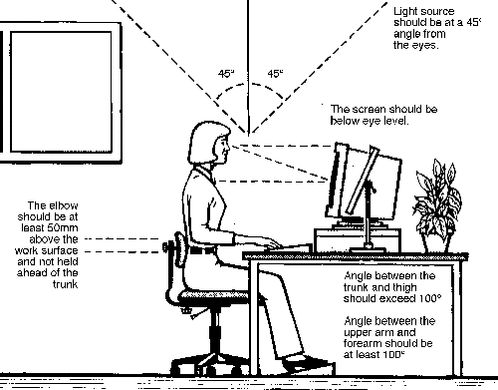Computer workstation ergonomics is highly important when setting up your computer. If your workstation is already set up check that most if not all conditions are meet. If not make as many changes as possible to archive this.
Requirements for safe workstation:
The Monitor
The Monitor
- Position the monitor to minimize glare by placing it at a right angle to light sources or windows
- Place the monitor as far away from you as possible while maintaining the ability to read without consciously focusing. Keep a minimum distance of 20 inches.
- Place the center of the screen at a 15 degree down angle from your eyes with your neck only slightly bent holding your head perpendicular to the floor.
- Align the monitor and the keyboard / mouse
- The office should be moderately bright (20-50 foot candles or equal to a nice day where sunglasses aren’t needed).
- Do not use task lighting for computer work.
- A mix of incandescent and fluorescent lights reduces flicker and provides good light color.
- Position the keyboard slightly below the elbow and at a negative angle to allow the wrists to remain straight when you sit in a slightly reclined posture
- Do NOT use the keyboard supports to raise the back up. Do NOT tilt the keyboard tray so that the back of the keyboard is higher than the front. Though design and a lot of prevailing information say you should tilt the keyboard to a positive angle like this, it is wrong. A negative angle that allows the wrists to stay in their natural wrist position is better. A positive angle is an repetitive stress injury waiting to happen.
- Place the mouse on the same level as and immediately next to the keyboard tray.
- Keep the mouse in the arc line of the keyboard so that you can reach it when rotating your arm from the elbow.
- Do NOT use a wrist rest while using the mouse. Your forearm needs to be free to move so you do not strain the wrist.
- Use arm rests.
- Place the lumbar support slightly below the waist line.
- Adjust the height of the chair so your feet can rest completely on the floor.
- Allow 1-3 inches between the edge of the seat and the back of your knees.
- Use a high back chair that supports your shoulder blades if at all possible
- Position your hips so that they are slightly higher than your knees while your feet are flat on the floor.
- Lean back slightly. Leaning the trunk back to somewhere between 100-130 degrees from parallel to the floor will open up the hips and ease pressure on the pelvis. I like 104 degrees myself. Make sure your chair back will support your shoulders at this angle while still providing good lumbar support.
- Hold your head slightly up so that it is roughly perpendicular to the floor.
- Let your upper arms hang naturally from your shoulders.
- Let your lower arms rest on the arm rests of your chair either parallel or slightly below, to the floor.
- Keep your wrists straight.
- Take frequent breaks. 10 minutes for every hour of work and 30 second micro-breaks every 10 minutes is a good schedule.
- Stretch during those breaks.
- Change your position frequently. Move your feet, lift your arms, adjust your hips, and just make sure to subtly alter your posture continuously throughout the work day.



 RSS Feed
RSS Feed